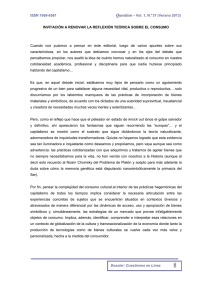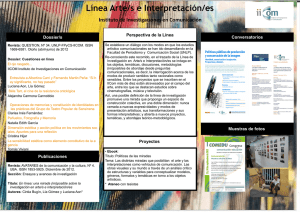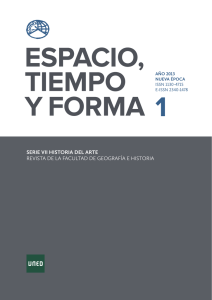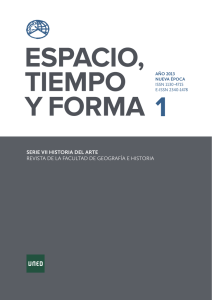PRESENTACION_EDITORIAL.pdf
Anuncio
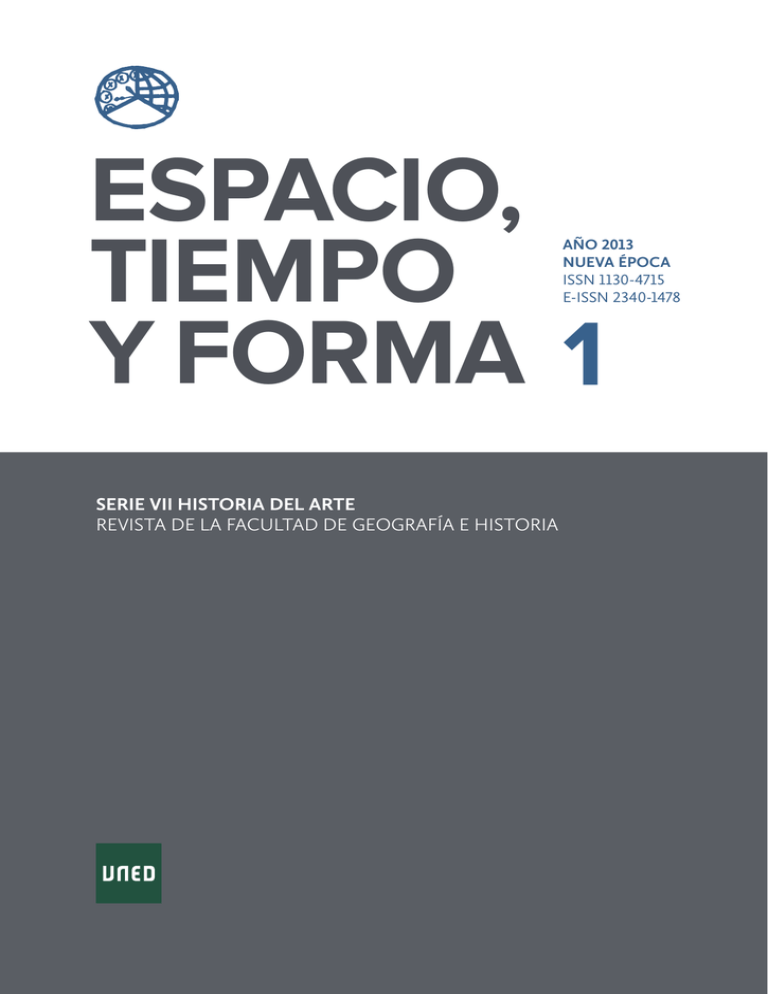
ESPACIO, TIEMPO Y FORMA 1 AÑO 2013 NUEVA ÉPOCA ISSN 1130-4715 E-ISSN 2340-1478 SERIE VII HISTORIA DEL ARTE REVISTA DE LA FACULTAD DE GEOGRAFÍA E HISTORIA ESPACIO, TIEMPO Y FORMA 1 AÑO 2013 NUEVA ÉPOCA ISSN 1130-4715 E-ISSN 2340-1478 SERIE VII HISTORIA DEL ARTE REVISTA DE LA FACULTAD DE GEOGRAFÍA E HISTORIA http://dx.doi.org/10.5944/etfvii.1.2013 UNIVERSIDAD NACIONAL DE EDUCACIÓN A DISTANCIA La revista Espacio, Tiempo y Forma (siglas recomendadas: ETF), de la Facultad de Geografía e Historia de la UNED, que inició su publicación el año 1988, está organizada de la siguiente forma: SERIE I — Prehistoria y Arqueología SERIE II — Historia Antigua SERIE III — Historia Medieval SERIE IV — Historia Moderna SERIE V — Historia Contemporánea SERIE VI — Geografía SERIE VII — Historia del Arte Excepcionalmente, algunos volúmenes del año 1988 atienden a la siguiente numeración: N.º 1 N.º 2 N.º 3 N.º 4 — Historia Contemporánea — Historia del Arte — Geografía — Historia Moderna ETF no se solidariza necesariamente con las opiniones expresadas por los autores. Espacio, Tiempo y Forma, Serie VII está registrada e indexada, entre otros, por los siguientes Repertorios Bibliográficos y Bases de Datos: dice, ISOC (cindoc), resh, in-rech, Dialnet, e-spacio, uned, circ, miar, francis, pio, Ulrich’s, sudoc, 2db, erih (esf). Universidad Nacional de Educación a Distancia Madrid, 2013 SERIE VII · Historia DEL ARTE (NUEVA ÉPOCA) N.º 1, 2013 ISSN 1130-4715 · e-issn 2340-1478 Depósito legal M-21.037-1988 URL ETF VII · HIstoria DEL ARTE · http://revistas.uned.es/index.php/ETFVII Diseño y composición Ángela Gómez Perea · http://angelagomezperea.com Sandra Romano Martín · http://sandraromano.es Impreso en España · Printed in Spain Esta obra está bajo una licencia Creative Commons Reconocimiento-NoComercial 4.0 Internacional. PRESENTACIÓN EDITORIAL Espacio, Tiempo y Forma. Serie VII es una revista científica de investigación en Historia del Arte publicada anualmente por el Departamento de Historia del Arte de la Facultad de Geografía e Historia de la UNED. Se dirige principalmente a la comunidad científica y universitaria, tanto nacional como internacional, así como a todos los profesionales de la Historia del Arte en general. La revista recoge artículos inéditos de investigación y debate sobre Historia del Arte, en especial trabajos que constituyan una aportación novedosa, que enriquezcan el campo de investigación que abordan u ofrezcan una perspectiva de análisis crítico. Los artículos publicados por Espacio, Tiempo y Forma. Serie VII son originales e inéditos, y siguen un riguroso proceso de evaluación por parte del Consejo de Redacción y de los evaluadores externos (sistema de doble ciego) que garantiza la calidad científica de las contribuciones. Aunque la revista acepta artículos en todos los idiomas, se priorizan el español y el inglés para favorecer su difusión, facilitando además el acceso sin restricciones a sus contenidos por medio de la edición electrónica. El presente número de la revista abre una nueva época tras 25 años de existencia en la que se consolida como revista electrónica por medio del sistema OJS, renovándose tanto su diseño editorial como los criterios de evaluación de la calidad científica en busca de un mayor impacto de la publicación. Entre las novedades de la etapa que iniciamos se incluye la incorporación de un dossier temático anual coordinado por un investigador o investigadora de referencia dentro de su especialidad, que incorpora dos artículos invitados y otras contribuciones seleccionadas y mejoradas por los procedimientos de revisión y evaluación externa. Además del dossier, la revista mantiene el apartado de temática libre e incorpora una sección de recensiones científicas. En el n.º 1 de Espacio, Tiempo y Forma. Serie VII. Nueva época hemos contado con la valiosa participación de Carlos Reyero Hermosilla (Catedrático de Historia del Arte, Universidad Pompeu Fabra) para la coordinación del dossier. Bajo el título Cómplices necesarios Reyero plantea una reflexión en la introducción sobre los distintos agentes que intervienen en la creación y percepción de la obra de arte. Felipe Pereda, como autor invitado del dossier, propone un modelo de análisis de la imaginería religiosa en la España altomoderna basado en el estudio de sus propios recursos narrativos y no tanto en su (supuesto) carácter devocional. El otro artículo invitado, escrito por Jesús Pedro Lorente, trata sobre la formación de dos colonias artísticas en el norte de Alemania a inicios del siglo XX, donde el espacio urbano se configura como un prematuro complejo museístico en el sentido moderno del término. Entre los trabajos recibidos y seleccionados para el dossier contamos con el artículo de Encarna Montero sobre el entorno valenciano del siglo XV, donde el presbítero Andreu Garcia desempeñó un papel destacado como mediador en distintos encargos, llegando a entablar estrechas relaciones con artistas y a practicar ESPACIO, TIEMPO Y FORMA Serie VII · historia del arte (n. época) 1 · 2013 ISSN 1130-4715 · e-issn 2340-1478 UNED 13 P resentación editorial él mismo la pintura. M.ª Alegra García, por su parte, aborda la iconografía de Juan Martínez Silíceo, cardenal y arzobispo de Toledo en la primera mitad del siglo XVI que fue rememorado tras su muerte en diversas fuentes literarias y visuales analizadas en este artículo. El trabajo escrito por Núria Fernández Rius y Nuria Peist profundiza en los orígenes de la fotografía y en los distintos intermediarios que participaron en su consolidación, planteando una reflexión sobre el modo en que la propia valoración estética, científica y comercial del arte fotográfico determina su desarrollo. En cuanto al artículo de Elena Marcén, se trata de un estudio sobre el museo como institución pública desde sus inicios en el siglo XVIII, observándose que el planteamiento expositivo condiciona la interpretación de la obra de arte y es capaz de construir una memoria colectiva. El dossier concluye con el trabajo de Vicenç Furió sobre Hilma af Klint, pintora sueca cuyo reconocimiento como pionera del arte abstracto ha dependido del apoyo de las instituciones artísticas que han dedicado exposiciones a su obra, convertidas en cómplices de su prestigio. El dossier se presenta en versión bilingüe español-ingles en la plataforma electrónica y se acompaña de los otros nueve artículos que conforman este número. En la sección de temática libre Manuel Jódar estudia la transformación de la mezquita aljama de Jaén en catedral recurriendo a las fuentes escritas de la época (siglos XIII a XV) ante la escasez de rastros arquitectónicos de la primitiva fábrica giennense. El siguiente artículo, escrito por Teresa Izquierdo, se centra en la trayectoria del oficio de maestro carpintero en la Valencia bajomedieval, analizando el proceso de emancipación de las diversas labores englobadas bajo este título conforme nos acercamos al siglo XV, hasta existir una completa independencia entre la carpintería y la obra de vila a mediados de este siglo. Antonio José Díaz, por su parte, identifica un retablo barroco de 1653, localizado hoy en la parroquia toledana de Nambroca, como obra del arquitecto madrileño Pedro de la Torre, tratándose de una obra inédita del artista. Otro artículo, el de Fernando R. Bartolomé y Laura Calvo, analiza el retablo de San Miguel Arcángel de Lazkao (Gipuzkoa), obra original barroca concluida en 1683 por Juan de Ursularre y transformada durante la centuria siguiente para adecuarla al gusto neoclásico. Algunos trabajos de este número se centran en manifestaciones artísticas de época contemporánea. Es el caso del de Javier Cuevas sobre la correspondencia de Sigmund Freud con André Breton, que explica el distanciamiento del padre del psicoanálisis respecto a las posturas surrealistas. El artículo de Francisco Javier Lázaro, por su parte, analiza la renovación de la fotografía española a mediados del siglo XX, cuyo realismo se conecta con el reportaje realizado por Eugene Smith sobre Deleitosa (Cáceres), señalándolo como un precedente significativo. Alicia Sánchez estudia en su artículo los valores asociados al color negro durante la historia del arte y especialmente en época contemporánea, profundizando en la capacidad de este color para la evocación de nociones negativas relacionadas con lo oculto, la muerte y el vacío, explicando la potencialidad del negro para la sugestión emocional y estética. El artículo de Óscar Muñoz plantea una reinterpretación de la obra del pintor Santiago Serrano durante los años setenta a partir de algunos escritos inéditos del 14 ESPACIO, TIEMPO Y FORMA Serie VII · historia del arte (n. época) 1 · 2013 ISSN 1130-4715 · e-issn 2340-1478 UNED E ditorial foreword artista. El último trabajo, de Antonio Jesús Sánchez, se centra en señalar la repercusión de los valores sobre patrimonio cultural en la actividad restauradora del momento, siendo ésta un producto de su tiempo. La revista finaliza con la sección de recensiones científicas que se inicia en este primer número de la nueva época. Madrid, diciembre de 2013 Inés Monteira Arias Editora de Espacio Tiempo y Forma. Serie VII. Historia del Arte EDITORIAL FOREWORD Espacio, Tiempo y Forma. Series VII is a scientific research journal in Art History, published annually by the UNED’s Department of Art History, part of its Faculty of Geography and History. It is dedicated primarily to the scientific and university community, both national and international, as well as to Art History professionals in general. The journal collects unpublished research and debate articles concerning Art History, particularly those works that represent a new contribution, that enrich the research area they tackle or that offer a critical analytical perspective. The articles published by Espacio, Tiempo y Forma. Series VII are original and unpublished, subject to a rigorous process of evaluation by the editorial board and external evaluators —a double-blind system— which guarantees the scientific quality of the contributions. Although the journal accepts articles in all languages, it prioritises Spanish and English to facilitate wide dissemination, and, furthermore, provides unlimited access to its content through its electronic edition. The current issue of the journal heralds a new era —following twenty-five years of existence— in which it consolidates itself as an electronic journal through the OJS system, revisiting both its editorial design and its criteria for ensuring scientific quality in search of a greater impact in its publication. Among the novelties introduced in this new phase is the inclusion of an annual thematic dossier, coordinated by a researcher foremost within their field, which incorporates two guest articles and other contributions selected and refined by the processes of external revision and evaluation. In addition to the dossier, the journal will continue its «open subject» section and introduce a section of scientific reviews. In issue number one of Espacio, Tiempo y Forma. Series VII. A New Era we have enjoyed the valuable participation of Carlos Reyero Hermosilla (Professor of Art History, Universidad Pompeu Fabra) for the coordination of the dossier. Under the title Necessary Accomplices, Reyero presents a reflection on the various agents that intervene in the creation and perception of the work of art. Felipe Pereda, ESPACIO, TIEMPO Y FORMA Serie VII · historia del arte (n. época) 1 · 2013 ISSN 1130-4715 · e-issn 2340-1478 UNED 15 E ditorial foreword as guest author of the dossier, proposes a model to analyse religious imagery in modern Spain, based on the study of its own narrative resources and less so on its (supposed) devotional nature. The second guest article —written by Jesús Pedro Lorente— deals with the formation of two artistic colonies in northern Germany in the early twentieth century, where the urban space was organised as a prototypical «museum» complex (in the modern sense of the word). Among the received works that were selected for the dossier is Encarna Montero’s article on the Valencian environment of the fifteenth century, where the presbyter Andreu Garcia played a crucial role as mediator in various commissions, coming to develop close relationships with artists and even to practice painting himself. María Alegra García, on the other hand, tackles the iconography of Juan Martínez Silíceo, Cardinal and Archbishop of Toledo in the first half of the sixteenth century, who was immortalised, following his death, in various literary and visual sources analysed in this article. The work written by Núria Fernández Rius and Nuria Peist delves into the origins of photography and the many intermediaries that took part in its consolidation, proposing a reflection on how the very recognition of the aesthetic, scientific and commercial value of the photographic arts determined their development. Elena Marcén’s article studies the museum as public institution, from its beginnings in the eighteenth century, observing how the expository process conditions our interpretation of the work of art and is capable of constructing a collective memory. The dossier concludes with Vicenç Furió’s work on Hilma af Klint, a Swedish painter whose recognition as a pioneer of abstract art has been dependent on the support of the artistic institutions that have dedicated exhibitions to her work, becoming accomplices in her prestige. The dossier is offered as a bilingual Spanish-English version through the electronic platform and accompanies the other nine articles that make up this issue. In the «open topic» section Manuel Jódar studies the transformation of Jaén’s Muslim mosque into a cathedral, employing the written sources of the time (thirteenth to fifteenth century) given the scarcity of architectural traces of the original construction. The next article, written by Teresa Izquierdo, explores the evolution of the post of master carpenter in Valencia during the high and late Middle Ages, analysing the process of emancipation —as we approach the fifteenth century— of the many activities this title encompassed, until the emergence of a complete independence between carpentry and the obra de vila in the middle of said century. Antonio José Díaz, in his paper, identifies a Baroque altarpiece from 1653, today located in the Toledan parish of Nambroca, as the work of the Madrid architect Pedro de la Torre, representing a heretofore unpublished work by the artist. Another article, written by Fernando R. Bartolomé and Laura Calvo, analyses the altarpiece of Archangel Michael in Lazkao (Gipuzkoa), an original Baroque work completed in 1683 by Juan de Ursularre and transformed during the following century to adapt it to neoclassical tastes. A number of works in this issue focus on artistic manifestations of a more contemporary nature. One such case is Javier Cuevas’ investigation into the correspondence between Sigmund Freud and André Breton, which explains the father 16 ESPACIO, TIEMPO Y FORMA Serie VII · historia del arte (n. época) 1 · 2013 ISSN 1130-4715 · e-issn 2340-1478 UNED E ditorial foreword of psychoanalysis’ distancing from surrealist principles. The article by Francisco Javier Lázaro, on the other hand, analyses the reinvigoration of Spanish photography in the mid-twentieth century, whose realism it links to Eugene Smith’s report on Deleitosa (Cáceres), identifying this latter as an important precedent. Alicia Sánchez studies the values associated with the colour black throughout the history of art, particularly in the contemporary period, scrutinising this colour’s capacity to evoke negative notions related to the occult, to death and to emptiness, explaining black’s potentiality for emotional and aesthetic suggestion. The article by Óscar Muñoz outlines a reinterpretation of Santiago Serrano’s painting work during the 1970s, based on a number of unpublished writings by the artist himself. The final paper, by Antonio Jesús Sánchez, illustrates how attitudes towards cultural heritage influence the restorative activity of a given period, this being a product of its time. The journal closes with the scientific review section, appearing for the first time in this pioneering issue of the new era. Madrid, December 2013 Inés Monteira Arias Editor, Espacio Tiempo y Forma. Serie VII. Historia del Arte ESPACIO, TIEMPO Y FORMA Serie VII · historia del arte (n. época) 1 · 2013 ISSN 1130-4715 · e-issn 2340-1478 UNED 17 AÑO 2013 NUEVA ÉPOCA ISSN: 1130-4715 E-ISSN 2340-1478 1 SERIE VII HISTORIA DEL ARTE REVISTA DE LA FACULTAD DE GEOGRAFÍA E HISTORIA Dossier Cómplices Necesarios por Carlos Reyero Hermosilla · Dossier Necessary Accomplices by Carlos Reyero 21 Carlos Reyero Introduction: Necessary Accomplices / Presentación: Cómplices necesarios Montero Tortajada 25 Encarna The Oligarch and the Brushes: a Biographical Sketch of Andreu Garcia, priest / El oligarca y los pinceles: breve semblanza del presbítero Andreu Garcia 45 María Alegra García García Some aspects about archbishop of Toledo don Juan Martínez Silíceo’s iconography (c.1477–1557) / Algunos aspectos en torno a la iconografía del arzobispo de Toledo don Juan Martínez Silíceo (c.1477–1557) ESPACIO, TIEMPO Y FORMA Izquierdo Aranda 199 Teresa Carpintero y maestro constructor en la arquitectura gótica valenciana / Carpenters and building mason in the Gothic architecture in Valencia (14th–15th centuries) José Díaz Fernández 223 Antonio El arquitecto madrileño Pedro de la Torre en Toledo y un retablo inédito localizado / The Architect of Madrid Pedro de la Torre in Toledo and a located unpublished altarpiece R. Bartolomé García & Laura Calvo García 247 Fernando Transformaciones en el retablo mayor de San Miguel Arcángel de Lazkao (Gipuzkoa). Del Barroco al Neoclasicismo / Changes in the main altarpiece of Saint Michael the Archangel in Lazkao (Gipuzkoa). From Baroque to Neoclassicism Pereda 67 Felipe Performing Doubt: the Art of Believing in Early Modern Spain / El Javier Lázaro Sebastián 265 Francisco La renovación de la fotografía española a partir de la pauta estética ejercicio de la duda: el arte de creer en la España alto Moderna del realismo. Un precedente formal y significativo en el reportaje de Eugene Smith sobre Deleitosa (Cáceres) / The renovation of the Spanish photography from the aesthetic guideline of the realism. A formal and significant precedent in Eugene’s Smith photographic article on Deleitosa (Cáceres) Lorente Lorente 83 Jesús-Pedro The mouseion ideal reinterpreted as art colony on the outskirts of Darmstadt and Hagen / El ideal del mouseion reinterpretado como colonia artística en las afueras de Darmstadt y Hagen Fernández Rius & Nuria Peist 109 Núria The photographic and the mediation system. Artistic, technical and commercial values in the beginning of photography / Lo fotográfico y el sistema mediador. Valores artísticos, técnicos y comerciales en los inicios de la fotografía Marcén Guillén 129 Elena Real museum, imaginary museum. Considerations around the concept of museum as metamorphosis scenery / Museo real, museo imaginario. Reflexiones en torno al concepto de museo como escenario de metamorfosis Cuevas del Barrio 277 Javier El posicionamiento de Sigmund Freud ante el Surrealismo a través de la correspondencia con André Breton / The position of Sigmund Freud regarding Surrealism through correspondence with André Breton Sánchez Ortiz 295 Alicia El vacío iluminado del negro / The illuminated void of black Óscar Muñoz Sánchez 317 Santiago Serrano (1970–1980): Hacia una pintura no aprehensible / Santiago Serrano (1970–1980). Towards a non-apprehensible painting Furió 147 Vicenç Fame and prestige: necessary and decisive accomplices in the case Jesús Sánchez Fernández 347 Antonio Restauración y metamorfosis de los valores del patrimonio cultural of Hilma af Klint / Fama y prestigio: cómplices necesarios y decisivos en el caso de Hilma af Klint / Restoration and Metamorphosis of the Values of Cultural Heritage Miscelánea · Miscellany 169 Manuel Jódar Mena De la aljama a la primitiva construcción gótica. Reflexiones a propósito de la Catedral de Jaén en época bajomedieval / From the Great Mosque to the former Gothic construction. Some observations on Jaén’s Cathedral during the late middle ages Reseñas · Book Review Nicola. Architettura del Tardo Rinascimento in Sicilia. Gio375 Aricò, vannangelo Montorsoli a Messina (1547–57). Firenze, Leo S. Olschi Editore, 2013. (Alicia Cámara Muñoz) Victoria. Dora Maar. Barcelona, Circe, 2013. (Amparo 379 Combalía, Serrano de Haro)
